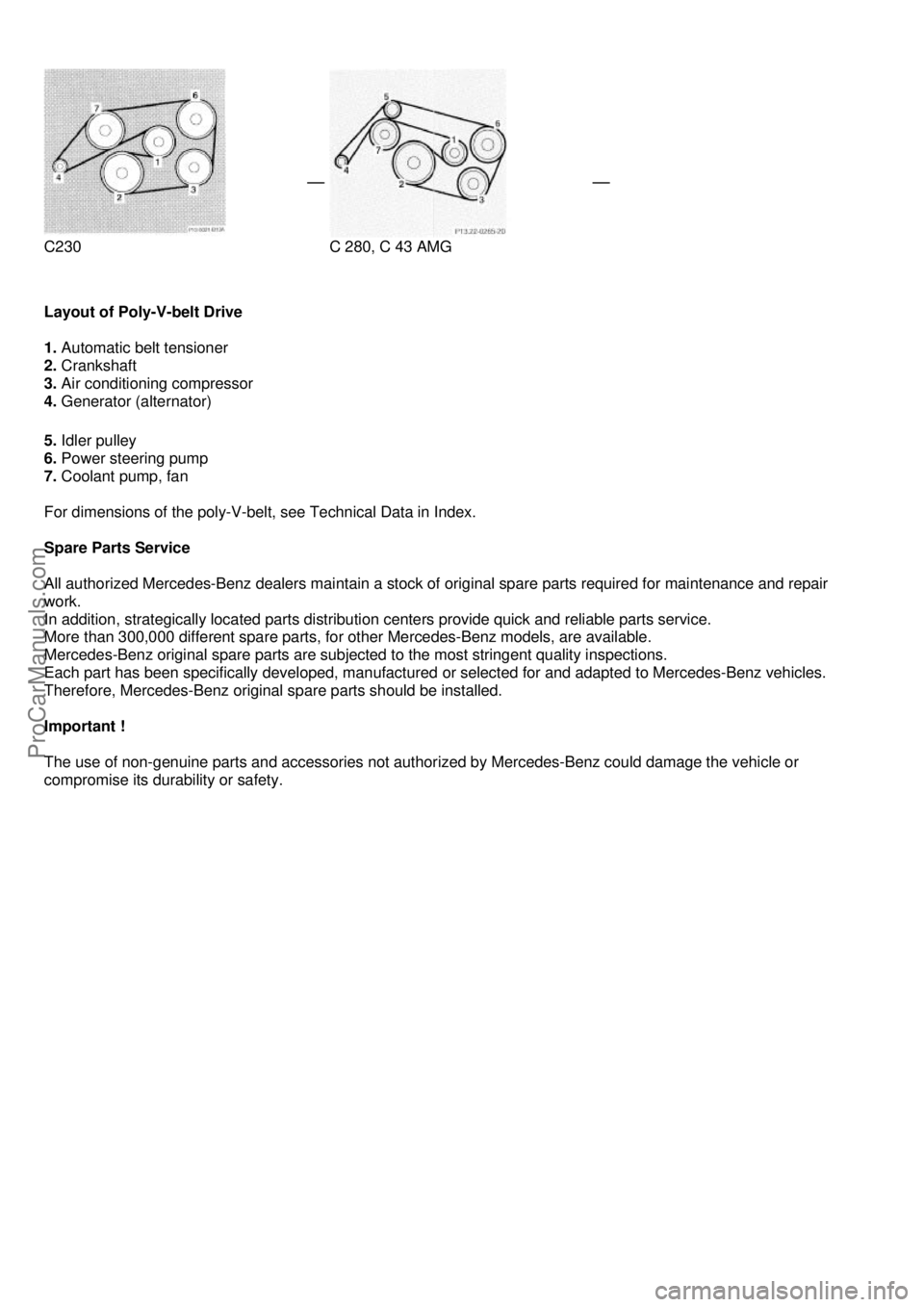1999 MERCEDES-BENZ C-280 service
[x] Cancel search: servicePage 70 of 122

Low Engine Coolant Level Warning Lamp
With the electronic key in steering lock position 2, the warning lamp comes on.
It should go out when the engine is running. If the warning lamp does not go out after starting the
engine, or if it comes on while driving, then the coolant level has dropped below the required level. If
no leaks are noticeable and the engine temperature does not increase, continue to drive to the
nearest service station and have coolant added to the coolant system (see Index).
The low engine coolant level warning light should not be ignored. Extended driving with the light
illuminated may cause serious engine damage not co vered by the Mercedes-Benz Limited Warranty.
In cases of major or frequent minor coolant lo ss, have the cooling system checked at your
authorized Mercedes-Benz dealer as soon as possible.
Note:
Do not drive without coolant in the cooling sy stem. The engine will overheat causing major engine
damage. Monitor the coolant temperature gauge while driving.
Warning !
Do not spill antifreeze on hot engine parts. Antifreeze contains ethylene glycol which may
burn if it comes into contact with hot engine parts. You can be seriously burned.
Low Windshield and Headlamp Washer System Fluid Level Warning Lamp
With the electronic key in steering lock position 2, the warning lamp comes on. It should go out when
the engine is running. If the warning lamp does not go out after starting the engine, or if it comes on
while driving, the level of the reservoir has droppe d to approx.1/4 of the total volume. The reservoir
should be refilled with MB Windshield Washer Concentrate "S" and water (or commercially available
premixed windshield washer solvent/antifreeze, depending on ambient temperature - see Index) at
the next opportunity. The reservoir for the windshie ld and headlamp washer systems is located in
the engine compartment.
ProCarManuals.com
Page 72 of 122

Flexible Service System (FSS)
The FSS permits a flexible service schedule that is dire
ctly related to the operating conditions of the vehicle.
The symbol
or appears in the main odometer field prior to the next suggested service. Depending on operating
conditions throughout the year, the nex t service is calculated and displayed in days or distance remaining. The
message is displayed for approx. 10 seconds when turning the electronic key in steering lock to position 2, or it can
be canceled manually by pressing button 0. Once the suggested term has passed, the message plus symbol
or
, preceded by a - (minus symbol) blinks, when turning t he electronic key to position 2. The FSS display can also
be called up for approx.10 seconds with display illuminated by pressing button 0 twice. Following a completed service
the Mercedes-Benz dealer sets the counter to 10 000 miles (Canada: 15 000 km) and 365 days.
The counter can also be set by any individual. To do so:
1 . Turn electronic key in steering lock to position 2.
2 . Within 4 seconds press button 0 twice.
3 . The present status for days or distance is displayed. Within 10 seconds turn electronic key in steering lock to
position 0.
4 . Press and hold button 0, while turning electronic key in steering lock to position 2 again. The present status for
days or distance is displayed once more. Continue to hold button 0 After approx. 10 seconds a signal sounds, and the
display shows 10 000 miles (Canada: 15000 km).
5 . Release button 0. If the FSS counter was inadvertently reset, have a Mercedes -Benz dealer correct it.
Notes:
When disconnecting vehicle battery for one or more days at a time, such days will not be counted. Any such days not
counted by the FSS can be added by your Mercedes-Benz de aler. The interval between services is determined by
the kind of vehicle operation. Driving at extreme speeds, and cold starts combined with short distance driving in which
the engine does not reach normal operating temperat ure, reduce the interval between services.
Model C 230:
The FSS allows for distances between 10 000 miles (Canada: 15 000 km) and 15 000 miles (Canada: 22 500 km),
or from 365 to 730 days between services.
Models C 280 and C 43 AMG:
The FSS allows for distances between 10 000 miles (Canada: 15 000 km) and 20 000 miles (Canada: 30 000 km),
or from 365 to 730 days between services. However you choose to set your reference numbers, the scheduled
services as posted in the Service Booklet must be followed to properly care for your vehicle.
ProCarManuals.com
Page 77 of 122

Emission Control
Certain systems of the engine serve to keep the toxic components of the exhaust gases within
permissible limits required by law. These syst ems, of course, will function properly only when
maintained strictly according to factory spec ifications. Any adjustments on the engine should,
therefore, be carried out only by qualified Merc edes-Benz authorized dealer technicians. Engine
adjustments should not be altered in any way. Moreover, the specified service jobs must be carried
out regularly according to Mercedes-Benz servicing requirements. For details refer to the Service
Booklet.
Warning !
Inhalation of exhaust gas is hazardous to your health. All exhaust gas contains carbon
monoxide, and inhaling it can cause unconsciousness and lead to death.
Do not run the engine in confined areas (such as a garage) which are not properly ventilated.
If you think that exhaust gas fumes are entering the vehicle while driving, have the cause
determined and corrected immediately. If you must drive under these conditions, drive only
with at least one window fully open.
On-Board Diagnostic System
The Sequential Multiport Fuel Injection (SFI) c ontrol module monitors emission control components
that either provide input signals to or receive output signals from the control module. Malfunctions
resulting from interruptions or failure of any of these components are indicated by the "CHECK
ENGINE" malfunction indicator lamp in the instrument cluster and are simultaneously stored in the
diagnostic module. If the "CHECK ENGINE" malfunc tion indicator lamp comes on, have the system
checked at your authorized Mercedes-Benz deal er as soon as possible. The control module
switches off the "CHECK ENGINE" indicator lamp if the condition, causing the lamp to come on, no
longer exists. An on-board diagnostic connector is located in the passenger compartment near to the
parking brake pedal, allowing the accurate identificat ion of system malfunctions through the readout
of diagnostic trouble codes.
ProCarManuals.com
Page 78 of 122

Winter Driving
Have your car winterized at your authorized Mercedes-Benz dealer before the onset of winter.
• Change the engine oil if the engine contains an oil which is not approved for winter operation.
For viscosity (SAE/CCMC class) and filling quantity, see Capacities: Fuels, Coolants,
Lubricants etc. in Index.
• Check engine coolant anticorr osion/antifreeze concentration.
• Additive for the windshield washer and headlamp cleani ng system: Add MB Concentrate "S" to a premixed
windshield washer solvent/antifreeze which is form ulated for below freezing temperatures (see Index).
• Test battery: Battery capacity drops with dec reasing ambient temperature. A well charged
battery helps to ensure that the engine can be started, even at low ambient temperatures.
• Tires: We recommend M+S rated radial-ply tires on all four wheels for the winter season. Observe
permissible maximum speed for M+S rated radial-ply tires and the legal speed limit.
Note:
In winter operation, the maximum effect iveness of the acceleration slip regulation or of the electronic traction system
can only be achieved with M+S rated radial-ply tires and/or snow chains recommended by Mercedes-Benz. Snow
chains maximize performance.
Snow Chains
Use only snow chains that are tested and recommended by Mercedes-Benz. Your authorized Mercedes-Benz dealer
will be glad to advise you on this subject. Chains should only be used on the rear wheels. Follow the manufacturer's
mounting instructions. Snow chains should only be driven on snow covered roads at speeds not to exceed 30 mph
(50 km/h). Remove chains as soon as possible when driving on roads without snow. For tips on driving on slippery
winter roads, refer to Index. Vehicles with Acceleration Slip Regulation (ASR) or Electronic Stability Program (ESP):
When driving with snow chai ns, press the ASR or ESP control switch, refer to Index.
Model C 43 AMG
Important!
Use of snow chains is permissible only on winter tire size 215/45 R 17 H M+S. Refer to "Rims - Tires" in section
"Technical Data" (see Index).
Travelling Abroad
Abroad, there is a widely-spread Mercedes-Benz service network at your disposal. If you plan to travel into areas
which are not listed in the index of your dealer directory, you should request pertinent information from your
authorized Mercedes-Benz dealer.
ProCarManuals.com
Page 86 of 122

Wheels
Replace rims or tires with the same designation, manufacturer and type as shown on the original part. See your
authorized Mercedes-Benz dealer for further information. See your authorized Mercedes- Benz dealer for information
on tested and recommended rims and tires for summer and wi nter operation. They can also offer advice concerning
tire service and purchase.
Tire Replacement
Front tires should be replaced in sets. Furthermore - in the event of tire replacement - the spare wheel (except model
C 43 AMG), if possible, should be used on the rear axle. Ri ms and tires must be of the correct size and type. For
dimensions, see "Technical Data". We recommend that y ou break in new tires for approx. 60 miles (100 km) at
moderate speed. It is imperative that the wheel mounting bolts be fastened to a tightening torque of 80 ft.lb. (110 Nm)
whenever wheels are mounted. For rim and tire specifications, refer to "Technical Data".
Warning !
Worn, old tires can cause accidents. If the tire tread is badly worn, or if the tires have sustained damage,
replace them. When replacing rims, use only genuine Mercedes-Benz wheel bolts specified for the particular
rim type. Failure to do so can result in the bolts loosening and possibly an accident.
Rotating Wheels
Rotation of wheels with summer tires does not apply to m odel C 43 AMG. The wheels can be rotated according to the
degree of tire wear while retaining the same direction of travel. Rotating, however, should be carried out at the
scheduled service intervals, before the characteristic tire wear pattern (shoulder wear on front wheels and tread
center wear on rear wheels) becomes visible, as otherwise the driving properties
Important !
Unidirectional tires must always be mounted with arrow on tire sidewall pointing in direction of vehicle forward
movement. Notes: Thoroughly clean the inner side of the w heels any time you rotate the wheels or wash the vehicle
underside. The use of retread tires is not recommended. Retread tires may adversely affect the handling
characteristics and safety of the vehicle. Dented or bent rims can cause tire pressure loss and damage to the tire
beads. For this reason, check rims for damage at regular in tervals. The rim flanges must be checked for wear before
a tire is mounted. Remove burrs, if any. Check and correct ti re inflation pressure after rotating the wheels. For Tire
Inflation Pressure refer to Index.
ProCarManuals.com
Page 95 of 122

Battery
Warning !
Failure to follow these instructions can result in severe injury or death. Never lean over batteries while
connecting, you might get injured. Battery fluid contains sulfuric acid. Do not allow this fluid to come in
contact with eyes, skin or clothing. In case it does, immediately flush affected area with water and seek
medical help if necessary. A battery will also produ ce hydrogen gas, which is flammable and explosive.
Keep flames or sparks away from battery, avoid im proper connection of jumper cables, smoking etc..
Important !
Battery maintenance information:
The battery is located in the trunk under the trunk floor. The fluid level must be checked at every A and B service.
Always insure that the fluid level is at the specified maximum level and that only distilled water is used. Failure to
maintain proper fluid level may result in cell deterioration and possible battery rupture. The service life of the battery is
dependent on its condition of charge. The battery should alwa ys be kept sufficiently charged, in order to last an
optimum length of time.
Therefore, we strongly recommend that you have the battery charge checked frequently, and corrected if
necessary, especially if you use the vehicle less than approximately 200 miles (300 km) per month, mostly for
short distance trips, or if it is not used for long periods of time.
Only charge a battery with a battery charger after the battery has been disconnected from the vehicle electrical circuit.
Always disconnect the battery negative lead first and connect last. When removing and connecting the battery,
always make sure that all electrical consumers are off and the electronic key is in steering lock position 0. The battery
and its vent tube must always be securely installed when the car is in operation. While the engine is running the
battery terminal clamps must not be loosened or detached, otherwise the generator and other electronic components
would be damaged.
Note:
After reconnecting the battery al so resynchronize the Express feature of the power windows
(see Power Windows in Index).
Battery Recycling
Batteries contain materials that can harm the environment with improper disposal. Large 12 Volt storage batteries
contain lead. Recycling of batteries is the preferred method of disposal. Many states require sellers of batteries to
accept old batteries for recycling.
ProCarManuals.com
Page 107 of 122

C230
C 280, C 43 AMG
Layout of Poly-V-belt Drive
1. Automatic belt tensioner
2. Crankshaft
3. Air conditioning compressor
4. Generator (alternator)
5. Idler pulley
6. Power steering pump
7. Coolant pump, fan
For dimensions of the poly-V-belt, see Technical Data in Index.
Spare Parts Service
All authorized Mercedes-Benz dealers maintain a stock of original spare parts required for maintenance and repair
work.
In addition, strategically located parts distributi on centers provide quick and reliable parts service.
More than 300,000 different spare parts, for other Mercedes-Benz models, are available.
Mercedes-Benz original spare parts are subjecte d to the most stringent quality inspections.
Each part has been specifically developed, manufactured or selected for and adapted to Mercedes-Benz vehicles.
Therefore, Mercedes-Benz original spare parts should be installed.
Important !
The use of non-genuine parts and accessories not authorized by Mercedes-Benz could damage the vehicle or
compromise its durability or safety.
ProCarManuals.com
Page 109 of 122

Warranty Coverage
Your car is covered under the terms of the "warranties" printed in the Owner's Service and
Warranty Information booklet and your authoriz ed Mercedes-Benz dealer will exchange or
repair any defective parts in accordance wi th the terms of the following warranties:
1 . New vehicle limited warranty
2 . Emission systems warranty
3 . Emission performance warranty
4 . California emission control systems warranty.
Loss of Owner's Service and Warranty Information Booklet
Should you lose your Owner's Service and Warr anty Information booklet, have your authorized
Mercedes-Benz dealer arrange for a replacement. It will be mailed to you.
ProCarManuals.com